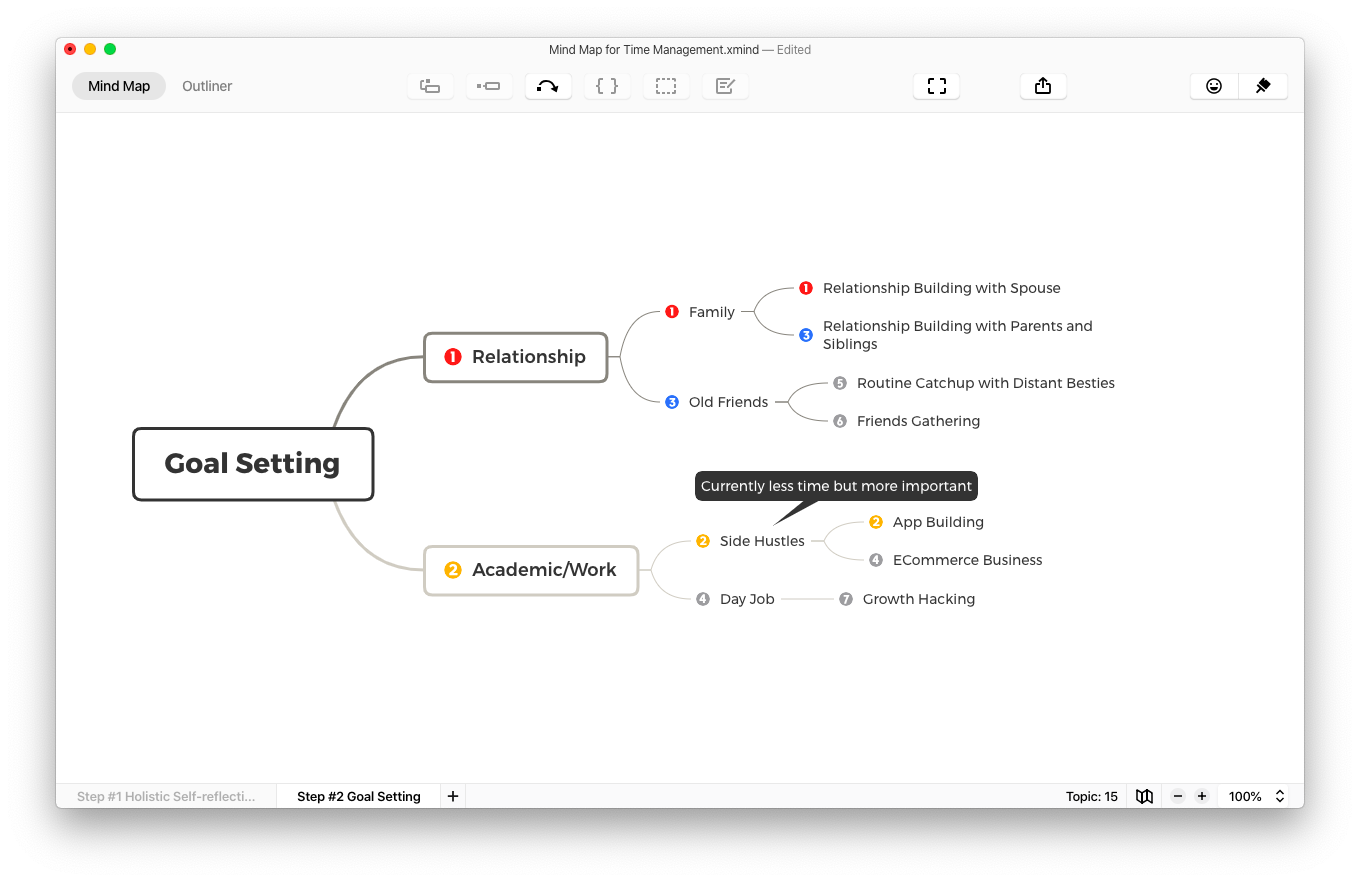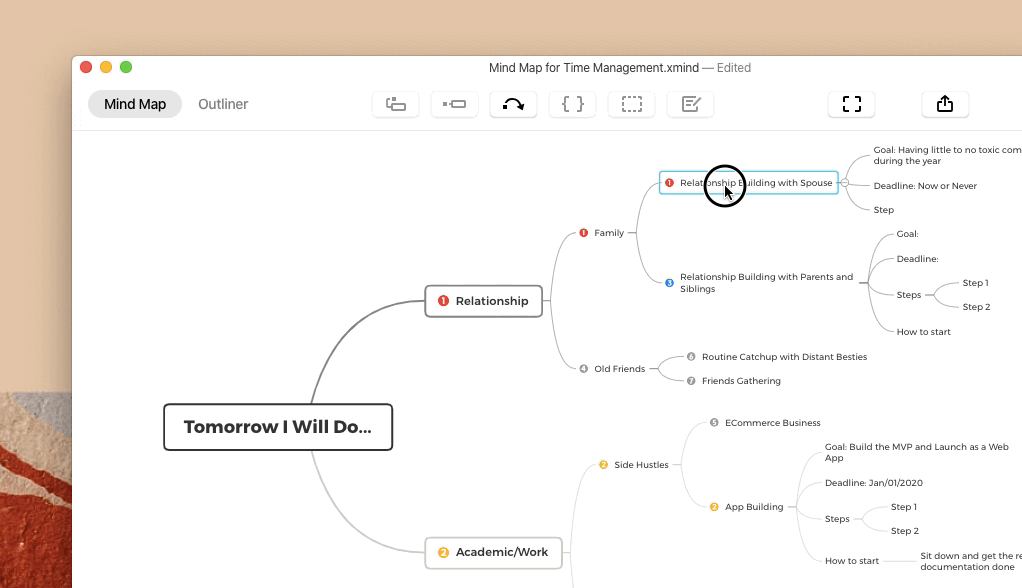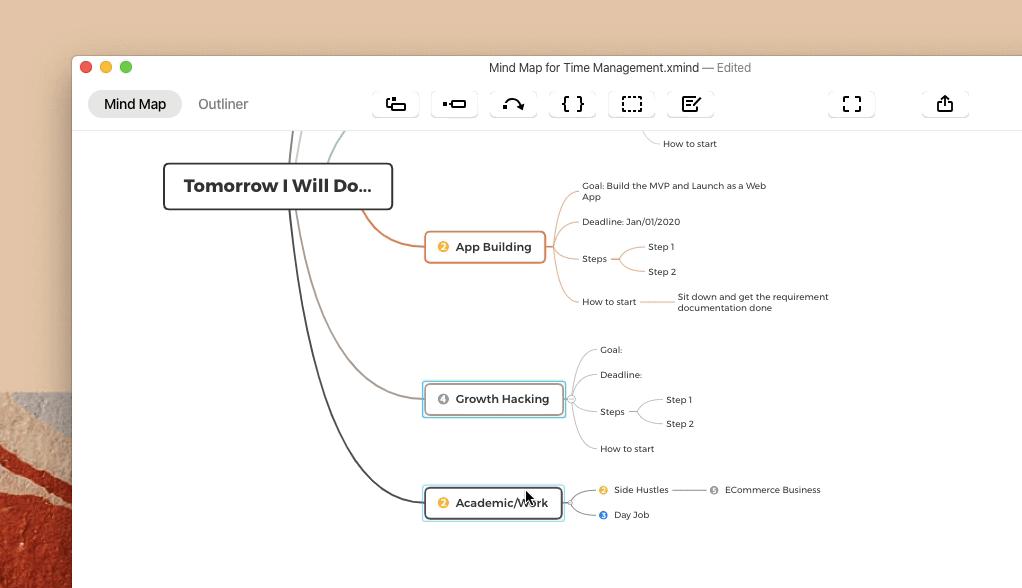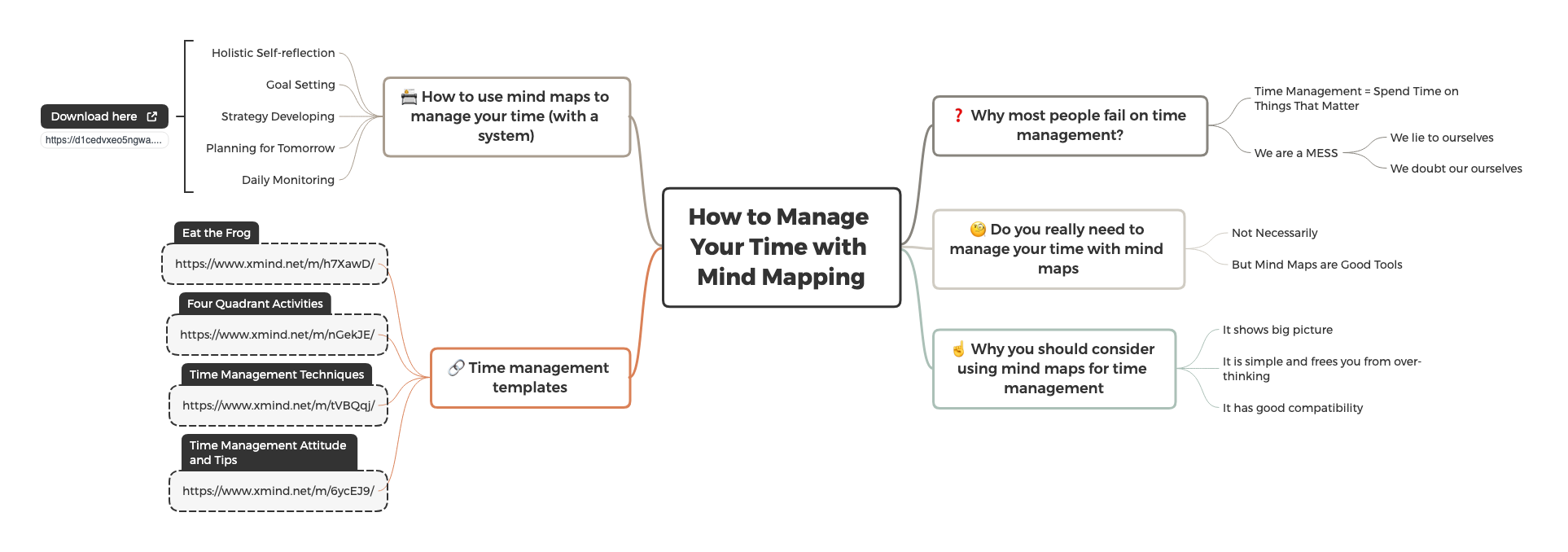Dec 12, 2019
How to Manage Your Time with Mind Mapping (Hint: You Don’t Always Need To)

Dec 12, 2019
How to Manage Your Time with Mind Mapping (Hint: You Don’t Always Need To)

If you waste one day after another, your chance of achieving isn't just an improbability, it's an impossibility.
But here's the thing: it's hard NOT to waste time.
Eating the frog is intimidating. The daily routine is boring. Worse than that, the journey seems endless.
You try out different methods, however, years gone by, things are still the same.
Then you come across mind mapping, and the advocacy about mind maps in productivity. Maybe this time, the case would be different?
If you're thinking about mind mapping your time and managing it, you are in the right place.
Here's what we'll be discussing in this article:
- Why do most people fail on time management?
- Do you really need to manage your time with mind maps
- Why you should consider using mind maps for time management
- How to use mind maps to manage your time (with a system)
- Time management templates
But first, you might be wondering…
Why most people fail on time management?
According to Wikipedia, time management means
"The process of planning and exercising conscious control of time spent on specific activities, especially to increase effectiveness, efficiency, and productivity."
To summarize, time management means that you spend time wisely - on things that matters to you.
Then why do we EVER fail? Don't we all want to spend time on things important to us?
Because we are such a mess!
Our brain loves to lie.
It lies to you that it is alright to scroll TikTok for a few minutes, that it is okay to work on easy but unimportant tasks, and that it is fine to wake up late in the morning.
And we love to doubt.
Is it really the one real thing? Why doesn't it work out that way? Maybe I should explore more?
No, it's not okay to waste time on TikTok. And we never know whether an idea works or not unless we get it real.
Do you really need to manage your time with mind maps?
Mind maps are tree charts that help you visually organize your information. They are easy-to-use tools embraced by many, including executives from big names.
But in the end, the mind map is a tool, a medium. So what matters is your system.
You can use mind maps, spreadsheets, or simply whiteboards and markers. So long as they are capable of deploying your system, go for it!
In summary, mind maps are useful in time management.
Why you should consider mind mapping for time management
Here are a few reasons why mind maps for time management is still a "thing":
- It shows you the big picture. Remember how easy we are to doubt ourselves? Seeing the big picture might be a savior to people who struggle for a long time. Mind maps have higher information density than linear notes, and well-designed mind maps tell you major ideas instantly. With easy fold-and-unfold, you can dive into the real thing without losing the big picture.
- It is simple and frees you from over-thinking. In XMind, adding topics is either Enter or Tab thing. And with most of the advanced features hidden (task info, format, etc.), you prevent yourselves from diving into fantasy - entering details for items far too ahead of you.
- It has excellent compatibility. Most mind map software provides some exports and integrations. In XMind, you can export to MS Word, Excel, or Evernote. Then when you want to extend in some aspect, you can easily combine your big picture with other tools. Having said that, be aware that build up mind map templates is only part of the battles. The real difficulties are your daily monitoring.
Don't worry, though, we've included some advice on how to do that in this very article.
How to control your time with mind mapping
It's time to get to the real stuff. The main idea here is to build a system with mind maps and monitor your progress every day.
It may take you some time to tweak it to the best format for you. But once you start, the minor trials and errors are manageable.
Below is the system that we summarize from best practices and has been proven effective by this study.
Step 01: Holistic self-reflection
Write down ALL the tasks you are doing, including hobbies or extracurricular activities.
You can write down all the big tasks in your life and then organize them in groups. At this stage, keep the tasks on a macro level.

Then prioritize items, from the first level to the lower levels.

This is an excellent chance to ask yourselves: what is the most crucial thing in my life at this stage? Use callout to explain priorities if necessary.

Related mind map template
Four-quadrant Activity Classifier
Step 02: Goal setting
Now duplicate this mind map to another sheet, and delete trivial tasks. Attention management is also part of time management. We avoid spending time on useless time.

Then write down actionable and challenging goals and deadlines for each activity.

Step 03: Strategy developing
Drill down to each task branch and focus on one planning at a time. In XMind, you can use Show Branch Only.

For each drill-down, note down steps to finish them. And specifically, how to kick-start it.

Thinking about how to start is very critical in dealing with challenging tasks. It eases our stress and turns things from hard to achievable.
Step 04: Planning for tomorrow
Now it's time to getting real.
Get back to the big picture and duplicate the "Goal and Strategy" sheet every night after your work.
Name the new sheet as the date you are planning for.
Then focus on the third-level (a.k.a. actionable, detailed tasks). Move them to the first level.

Delete other unimportant points, then do the final organizing.

You will get your to-do list for tomorrow. You can click the image to download the template.
Bonus tips
MCII
The system is almost set up, only one last step to prevent you from downfalls - MCII.
MCII (Mental contrast with implementation intentions) is a well-tested technique to help you overcome pitfalls in achieving goals.
MC stands for contrasts between positive future images (your goals) and negative realities (roadblocks). For example:
- 🥅 goal: "finish a blog post tomorrow."
- 😩 negative reality can be: "wander around for fancy articles when I check my email in the morning."
II is your tackles against roadblocks. For the example above, you can write:
- 😩 negative reality: "wander around when checking emails."
- 🎯 implementation intention: "set a 2-minute alarm before checking email inbox."
For each goal, it can have multiple negative realities. And so is the case between negative realities and implementation intentions.
You need to come with up actionable, realistic counter attacks for your negative realities. Both MC and II need to include How, When, and Where to make them concrete.
Step 05: Daily monitoring
Start your day by checking the task lists and track the time.
![]()
Eat the frogs (aka. kill the most important tasks). It will be hard. And like in many other days, you doubt yourself a lot. When that happens, look at the big picture and your goal. With the everyday small steps, you are going to make to the bright future!
If you still struggle, use a 20-second rule. Set up a 20-second alarm, and tell yourself,
"I only need to do for 20-seconds, then I can stop! "
You'll find that you do not want to stop.
But to make it sustainable, you need to reward yourself by resting and celebrating. Otherwise, your brain might not trust you anymore.
Bonus tips
Hold on for 4 weeks
Forming a habit is hard, but it might not task as long as you think.
The system in this article is based on a study in 2014. During the experiment, no noticeable improvements showed up after 2 weeks of time management. But after 4 weeks, students report significantly higher control of time and less stress. These two are two critical indicators of academic success.
The sad truth is 50% of students dropped out of the study after 2 weeks. So be alert and prepared, it will be tough to persist in the first 2 weeks.
Time management templates
To know more about time management techniques, you can check out the following templates. 👇
How to eat that frog: 21 principles to stop procrastinating
Organize your tasks according to importance and urgency
Time management tips and attitude
Time management techniques
Final thoughts
Time management is dead simple in theory, but crazy hard in practice. We all probably need to struggle the whole life to fight against time wasters.
But so long as we remind ourselves about our goals and keep tracking the daily work. Bit by bit. And one day, time management may not be an issue to concern anymore.
If you find any point missing here, leave a comment below, or tweet me.
Happy time managing 😎.
More Posts
Flowchart Essentials: Definition, Templates, and Free Softwares
Discover the power of flowcharts with our detailed guide. Learn what a flowchart is, explore practical use cases, and discover how to create and optimize them using softwares like Xmind and Xmind AI for enhanced workflow efficiency.

Bubble Maps: Definition, Examples, and How to Create in Xmind
Discover the power of bubble maps for data visualization with our comprehensive guide. Learn about different types, practical applications, and best mind mapping tools like Xmind. Get step-by-step instructions and expert tips to create stunning bubble maps for brainstorming, project management, and report writing.

The Plan-Do-Check-Act (PDCA) Cycle, Explained (+Mind Map Examples of PDCA)
PDCA is a simple yet effective methodology that can help you improve your work processes and get better results. By following the cycle's four steps - Plan, Do, Check, and Act - you can achieve continuous improvement in your operations, leading to better quality, increased efficiency, and greater customer satisfaction. Xmind is a great tool for implementing the PDCA model.


One space for all your ideas
Organize thoughts, visualize structures, connect ideas, and unlock insights.
Get Started for Free







